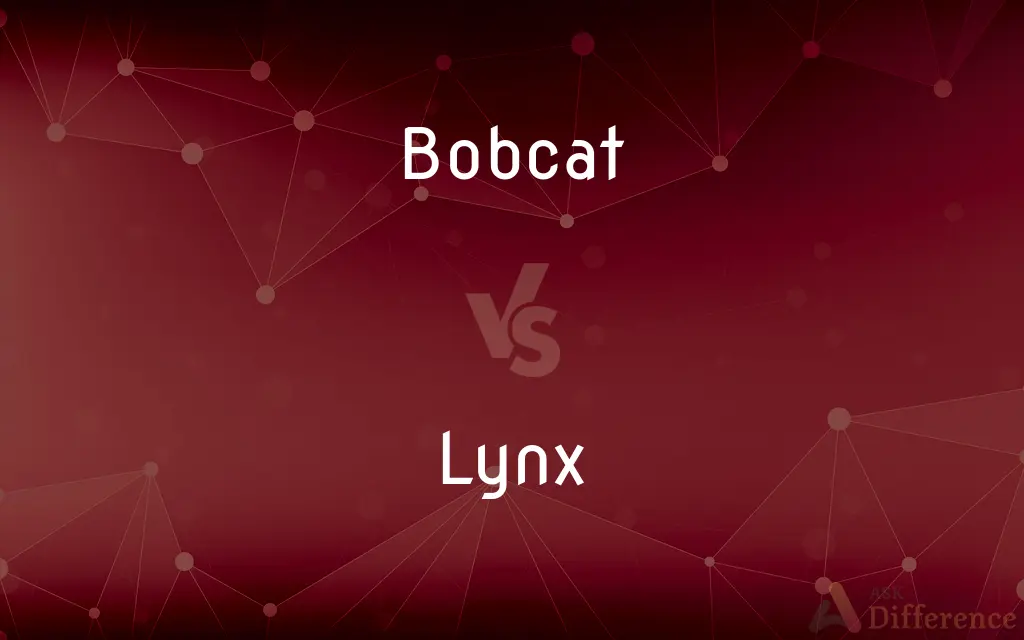Bobcat vs. Lynx — What's the Difference?
By Tayyaba Rehman — Updated on September 18, 2023
A Bobcat is a North American wildcat with tufted ears and a short tail, while a Lynx is a genus of wildcats found in various parts of the world, characterized by pointed tufts on their ears.

Difference Between Bobcat and Lynx
Table of Contents
ADVERTISEMENT
Key Differences
Both Bobcat and Lynx are wildcats belonging to the Felidae family. While the Bobcat is primarily found in North America, the term Lynx encompasses four different species spread across the Northern Hemisphere.
Physically, the Bobcat is known for its spotted coat, short tail, and robust build. In contrast, Lynx species generally possess longer legs, larger feet, and a more pronounced facial ruff, distinguishing them from the Bobcat.
Behaviorally, Bobcats are adaptable predators and can thrive in a variety of environments, from forests to suburban areas. Lynx, especially the Eurasian and Canadian species, prefer colder climates and are heavily reliant on specific prey, like the snowshoe hare.
In terms of size, Bobcats are typically smaller than most Lynx species. The Bobcat measures up to 49 inches long, whereas the Eurasian Lynx, one of the largest Lynx species, can reach lengths of up to 51 inches.
To summarize, while both Bobcat and Lynx share several similarities as wildcats, they differ in their distribution, physical characteristics, behavior, and size. The Bobcat is a distinct species in North America, while the term Lynx refers to a genus containing several species.
ADVERTISEMENT
Comparison Chart
Distribution
Primarily North America.
Various parts of the Northern Hemisphere.
Physical Characteristics
Spotted coat, short tail.
Pointed ear tufts, facial ruff.
Size
Generally smaller.
Typically larger, depending on species.
Preferred Habitat
Varied environments.
Often colder climates.
Grammatical Use
Typically used as a noun.
Noun; refers to a genus of wildcats.
Compare with Definitions
Bobcat
Adaptable predator found in various habitats.
Bobcats can often be spotted near urban areas.
Lynx
Possesses a facial ruff and often a short tail.
The thick fur around the Lynx's face protects it from the cold.
Bobcat
Recognizable by its short, "bobbed" tail.
She identified the animal as a Bobcat by its tail.
Lynx
Larger feet adapted for snowy environments.
The Lynx has feet that act like natural snowshoes.
Bobcat
A North American wildcat with tufted ears.
The Bobcat prowled quietly through the forest.
Lynx
A genus of wildcats with pronounced ear tufts.
The Lynx is known for its iconic pointed ears.
Bobcat
A member of the Lynx genus but distinct in appearance.
While similar, the Bobcat has unique features compared to other Lynx species.
Lynx
Found in various parts of the Northern Hemisphere.
The Eurasian Lynx roams large territories in Europe and Asia.
Bobcat
The bobcat (Lynx rufus), also known as the red lynx, is a medium-sized cat native to North America. It ranges from southern Canada through most of the contiguous United States to Oaxaca in Mexico.
Lynx
Prefers colder climates and specific prey.
The Lynx relies heavily on snowshoe hares for food.
Bobcat
A wild cat (Lynx rufus) of North America, having spotted reddish-brown fur, tufted ears, and a short tail. Also called bay lynx.
Lynx
A lynx (; plural lynx or lynxes) is any of the four species (the Canada lynx, Iberian lynx, Eurasian lynx, or bobcat) within the medium-sized wild cat genus Lynx. The name lynx originated in Middle English via Latin from the Greek word λύγξ, derived from the Indo-European root leuk- ('light, brightness') in reference to the luminescence of its reflective eyes.
Bobcat
A North American wildcat, Lynx rufus, having tufted ears and a short tail.
Lynx
Any of several wildcats of the genus Lynx, especially L. canadensis of northern North America or L. lynx of Eurasia, having soft thick fur, a black-tipped short tail, and tufted ears.
Bobcat
A multi-purpose construction vehicle, akin to a smaller version of a front-end loader or a backhoe (backhoe loader), with a one-man caged control cabin.
Lynx
Lynx A constellation in the Northern Hemisphere, near Auriga and Gemini.
Bobcat
Small lynx (Lynx rufus) of North America.
Lynx
Any of several medium-sized wild cats, mostly of the genus Lynx.
Bobcat
Small lynx of North America
Lynx
Any one of several species of feline animals of the genus Felis, and subgenus Lynx. They have a short tail, and usually a pencil of hair on the tip of the ears.
Bobcat
Medium-sized wildcat with a robust build.
The muscular Bobcat is a formidable hunter.
Lynx
One of the northern constellations.
Lynx
Short-tailed wildcats with usually tufted ears; valued for their fur
Common Curiosities
Where can you find a Bobcat in the wild?
Bobcats are primarily found in North America, in varied environments from forests to suburban areas.
Are Bobcats and Lynx the same?
No, while they belong to the same family, they are distinct species with different characteristics.
How can I differentiate a Bobcat from a Lynx?
Bobcats are generally smaller with a spotted coat and short tail, while Lynx have longer legs, larger feet, and a facial ruff.
Are Lynx endangered?
Some species, like the Iberian Lynx, are critically endangered, while others have stable populations.
What do Bobcats eat?
Bobcats are carnivorous and feed on small mammals, birds, and reptiles.
How many species of Lynx are there?
There are four main species: Eurasian Lynx, Canadian Lynx, Iberian Lynx, and the Bobcat.
Are Bobcats and Lynx aggressive towards humans?
Generally, both avoid humans, but like any wild animal, they can be aggressive if threatened.
Can Bobcats climb trees?
Yes, Bobcats are skilled climbers and often climb trees to hunt or rest.
Is it legal to own a Lynx or Bobcat as a pet?
Laws vary by location, but in many places, it's illegal or requires special permits.
Can Bobcats swim?
Yes, while not common, Bobcats can swim when necessary.
Do Lynx and Bobcats hibernate?
No, neither hibernates, but they adapt their behavior for winter conditions.
How long do Lynx and Bobcats live?
In the wild, they can live up to 10-14 years, and potentially longer in captivity.
What's the primary prey for Lynx?
Snowshoe hares are the main prey, especially for the Canadian Lynx.
How big can a Lynx get?
Depending on the species, a Lynx can weigh between 20-66 pounds, with the Eurasian Lynx being the largest.
Are Bobcats nocturnal?
Yes, Bobcats are primarily nocturnal, active during the night.
Share Your Discovery

Previous Comparison
Noble vs. Sublime
Next Comparison
Scornful vs. AbusiveAuthor Spotlight
Written by
Tayyaba RehmanTayyaba Rehman is a distinguished writer, currently serving as a primary contributor to askdifference.com. As a researcher in semantics and etymology, Tayyaba's passion for the complexity of languages and their distinctions has found a perfect home on the platform. Tayyaba delves into the intricacies of language, distinguishing between commonly confused words and phrases, thereby providing clarity for readers worldwide.
















































